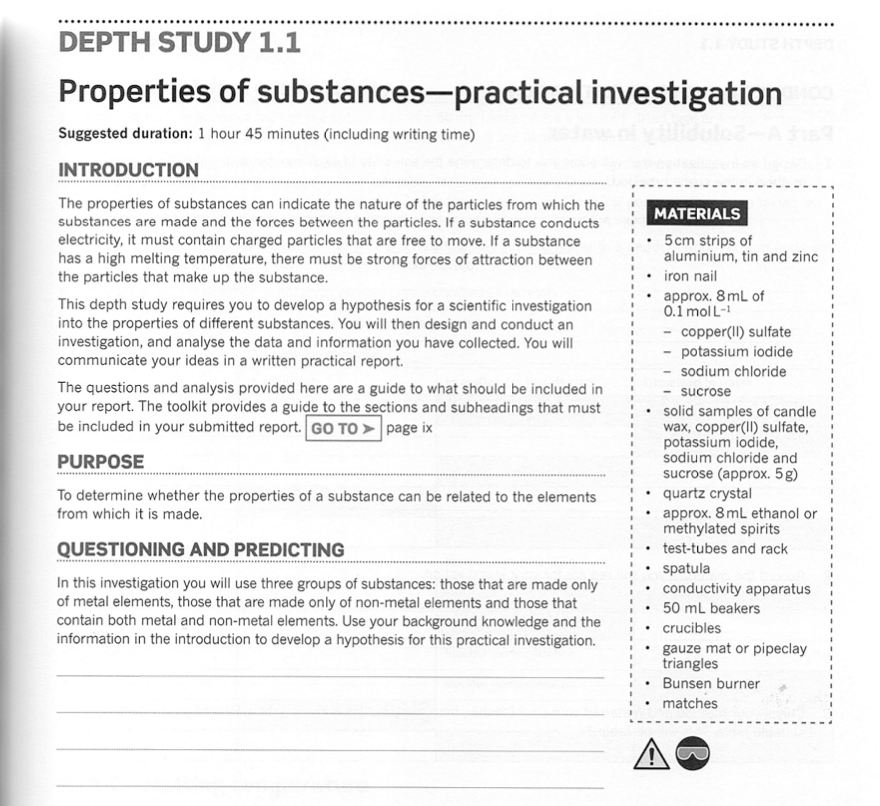
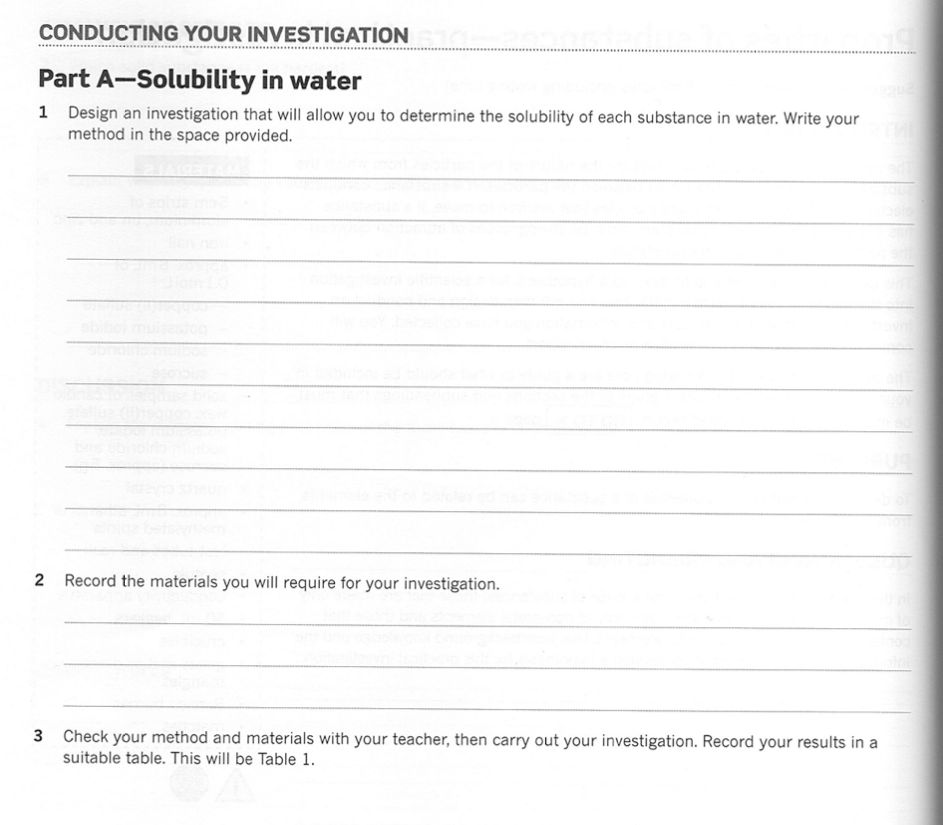
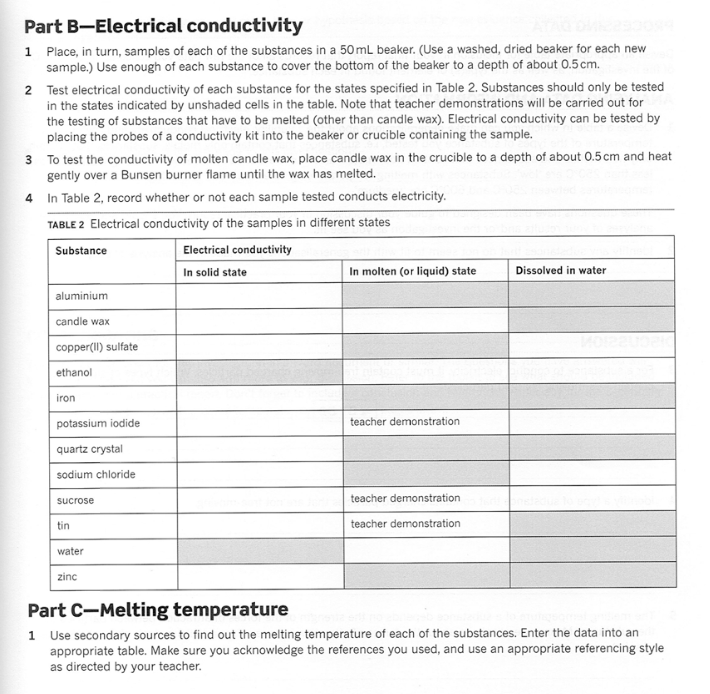
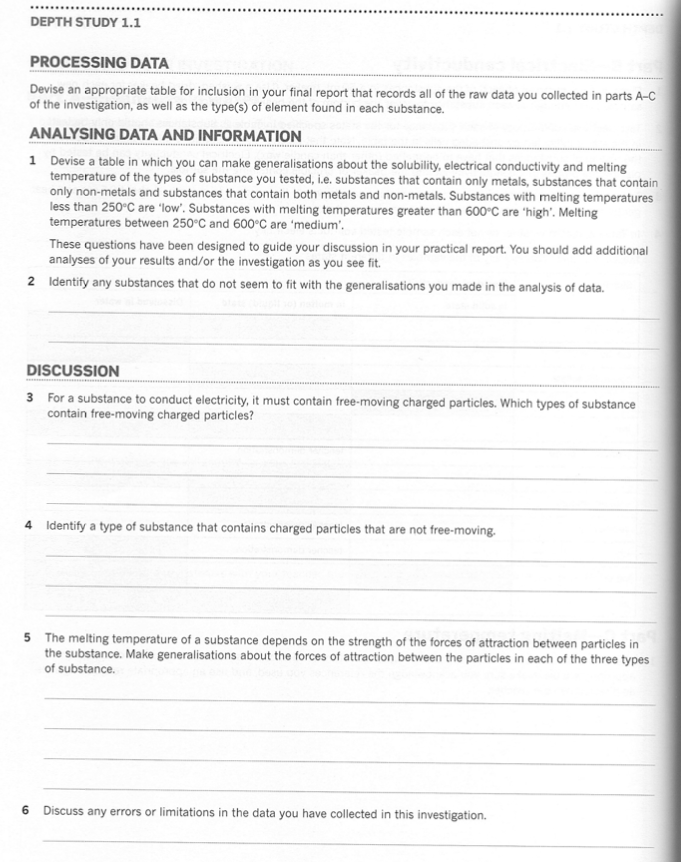
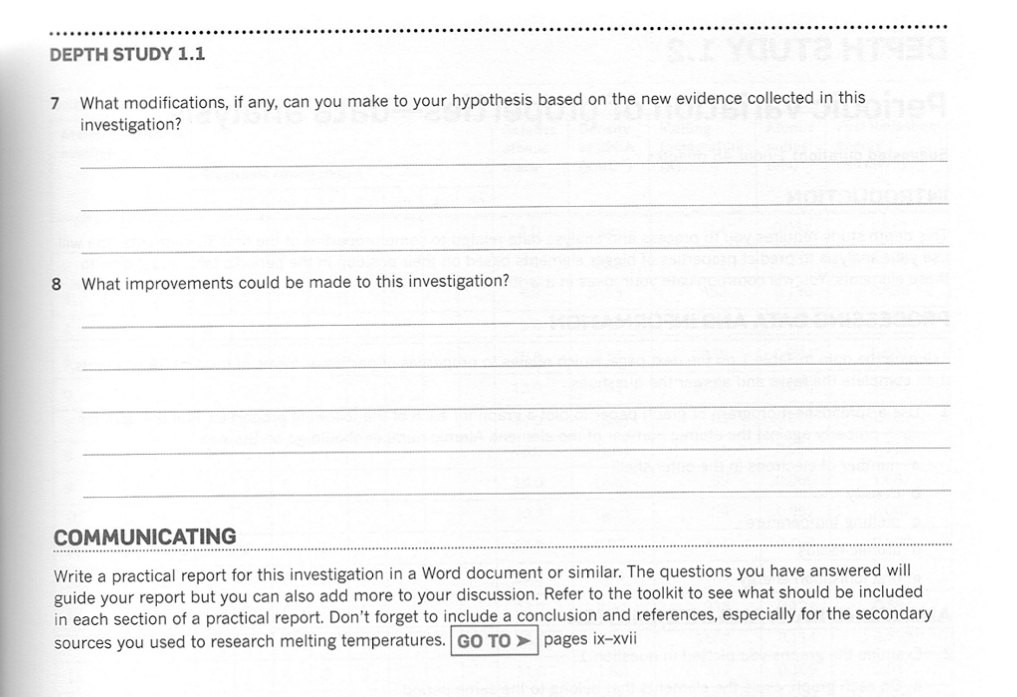
DEPTH STUDY 1.1 Properties of substances-practical investigation Suggested duration: 1 hour 45 minutes (including writing time) INTRODUCTION The properties of substances can indicate the nature of the particles from which the substances are made and the forces between the particles. If a substance conducts MATERIALS electricity, it must contain charged particles that are free to move. If a substance 5cm strips of has a high melting temperature, there must be strong forces of attraction between aluminium, tin and zinc the particles that make up the substance. iron nail approx. 8mL of This depth study requires you to develop a hypothesis for a scientific investigation 0.1 mol L- into the properties of different substances. You will then design and conduct an - copper(II) sulfate investigation, and analyse the data and information you have collected. You will - potassium iodide communicate your ideas in a written practical report - sodium chloride The questions and analysis provided here are a guide to what should be included in - sucrose your report. The toolkit provides a guide to the sections and subheadings that must solid samples of candle be included in your submitted report. GO TO > page ix wax, copper(II) sulfate, potassium iodide, PURPOSE sodium chloride and sucrose (approx. 58) To determine whether the properties of a substance can be related to the elements quartz crystal from which it is made. approx. 8mL ethanol or methylated spirits QUESTIONING AND PREDICTING test-tubes and rack spatula In this investigation you will use three groups of substances: those that are made only conductivity apparatus of metal elements, those that are made only of non-metal elements and those that 50 ml beakers contain both metal and non-metal elements. Use your background knowledge and the crucibles information in the introduction to develop a hypothesis for this practical investigation. gauze mat or pipeclay triangles Bunsen burner matches A CONDUCTING YOUR INVESTIGATION Part A-Solubility in water 1 Design an investigation that will allow you to determine the solubility of each substance in water. Write your method in the space provided. 2 Record the materials you will require for your investigation. 3 Check your method and materials with your teacher, then carry out your investigation. Record your results in a suitable table. This will be Table 1. Part B-Electrical conductivity 1 Place, in turn, samples of each of the substances in a 50 ml beaker. (Use a washed, dried beaker for each new sample.) Use enough of each substance to cover the bottom of the beaker to a depth of about 0.5 cm. 2 Test electrical conductivity of each substance for the states specified in Table 2. Substances should only be tested in the states indicated by unshaded cells in the table. Note that teacher demonstrations will be carried out for the testing of substances that have to be melted (other than candle wax). Electrical conductivity can be tested by placing the probes of a conductivity kit into the beaker or crucible containing the sample. 3 To test the conductivity of molten candle wax, place candle wax in the crucible to a depth of about 0.5 cm and heat gently over a Bunsen burner flame until the wax has melted. 4 In Table 2, record whether or not each sample tested conducts electricity. TABLE 2 Electrical conductivity of the samples in different states Substance Electrical conductivity In solid state In molten (or liquid) state Dissolved in water aluminium candle wax copper(II) sulfate ethanol teacher demonstration iron potassium iodide quartz crystal sodium chloride sucrose teacher demonstration teacher demonstration tin water zinc Part C-Melting temperature 1 Use secondary sources to find out the melting temperature of each of the substances. Enter the data into an appropriate table. Make sure you acknowledge the references you used, and use an appropriate referencing style as directed by your teacher. DEPTH STUDY 1.1 PROCESSING DATA Devise an appropriate table for inclusion in your final report that records all of the raw data you collected in parts A-C of the investigation, as well as the type(s) of element found in each substance. ANALYSING DATA AND INFORMATION 1 Devise a table in which you can make generalisations about the solubility, electrical conductivity and melting temperature of the types of substance you tested, i.e. substances that contain only metals, substances that contain only non-metals and substances that contain both metals and non-metals. Substances with melting temperatures less than 250C are 'low'. Substances with melting temperatures greater than 600C are 'high'. Melting temperatures between 250C and 600C are 'medium'. These questions have been designed to guide your discussion in your practical report. You should add additional analyses of your results and/or the investigation as you see fit. 2 Identify any substances that do not seem to fit with the generalisations you made in the analysis of data. DISCUSSION 3 For a substance to conduct electricity, it must contain free-moving charged particles. Which types of substance contain free-moving charged particles? 4 Identify a type of substance that contains charged particles that are not free-moving. 5 The melting temperature of a substance depends on the strength of the forces of attraction between particles in the substance. Make generalisations about the forces of attraction between the particles in each of the three types of substance. 6 Discuss any errors or limitations in the data you have collected in this investigation. DEPTH STUDY 1.1 7 What modifications, if any, can you make to your hypothesis based on the new evidence collected in this investigation? 8 What improvements could be made to this investigation? COMMUNICATING Write a practical report for this investigation in a Word document or similar. The questions you have answered will guide your report but you can also add more to your discussion. Refer to the toolkit to see what should be included in each section of a practical report. Don't forget to include a conclusion and references, especially for the secondary sources you used to research melting temperatures. GO TO > pages ix-xvii











